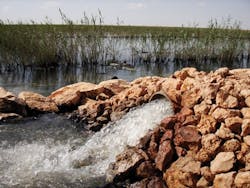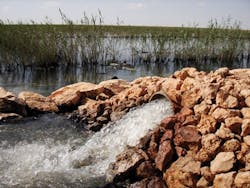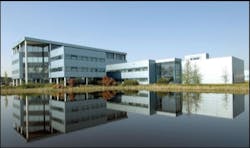In May 2009, the Jesusita wildfire roared through Santa Barbara, California, creating significant property and land damage to thousands of acres in its path. The fire ravaged large expanses of vegetation in the watershed surrounding Lauro Reservoir, which is part of the larger federal Cachuma Project operated by the Cachuma Operations and Maintenance Board (COMB), leaving the soils and ultimately the reservoir vulnerable.
The Cachuma Project water delivery system, which consists of several balancing reservoirs and more than 26 miles of conduit, includes Lauro Reservoir and supplies 85 percent of the potable water to the south coast of Santa Barbara County.
Without vegetation, the steep 2:1 slopes surrounding Lauro Reservoir were highly susceptible to severe erosion, raising concern that the eroded soil and ash from the fire might run downhill and accumulate, threatening the water quality of the reservoir.
Figure 1: When sprayed out, the product conforms to the soil, accounting for any irregularities in the terrain.
Specification
COMB needed a method of protecting and revegetating the steep slopes without introducing toxic or unnatural products into the water supply. They also wanted immediate and interim protection for the site while vegetation was being established.
Once the fire burned away the site's vegetation, the scorched earth that remained was powdery and easily erodible by wind and water. Because the land was unstable, COMB determined that 23 acres of land should be treated with a seeded erosion product.
COMB consulted with erosion control specialist Van Vermeesch of Aqua-Flo Supply (Ventura, CA), a supplier of irrigation materials, who determined that North American Green's hydraulically applied HydraCX2® Extreme Slope Matrix™ was the right product for the job. Surpassing toxicity requirements as established by EPA testing protocol, the product is non-toxic and contains all-natural fibers. Vermeesch and COMB were confident that it would safely and effectively deter stormwater runoff and promote vegetation to properly restore the reservoir.
Installation
Prior to the December 2009 application of the product, the site was prepared using minimal logging practices followed by biomass and soil redistribution to smooth the land where charred trees and other living vegetation once stood.
On the longer slope reaches, approximately 4,000 linear feet of North American Green's SedimentSTOP® Biodegradable Filtration System was installed to break up the slope and slow runoff water. This temporary measure was put in place until the HydraCX2 was applied and established vegetation could eventually step into that role. Silt fence was also used as an additional, and final, measure to control sediment runoff.
Shortly after the biodegradable filtration system was installed, Jon and Dawn Colbert of Santa Barbara's Acacia Erosion Control were tasked with applying the HydraCX2 product to the slopes using both a truck cannon and a handheld hose for optimal coverage.
After careful review of the site, including environmental, climate and terrain considerations, COMB selected a custom native seed mix. The seed combination was mixed directly with the product in the tanks, and the mixture was applied at a rate of 4,000 lbs/acre.
How It Works
Developed by Mulch and Seed Innovations, LLC (Centre, AL), along with Cotton Incorporated, HydraCX2 is a hydraulic erosion control product (HECP) made with mechanically processed straw fibers and reclaimed cotton plant material. It is a high-performance product containing proprietary performance-enhancing tackifiers that form a protective layer to hold soils in place and increase vegetation establishment.
The fiber matrix contains beneficial nitrogen, phosphorus and potassium nutrients that, when made available to the soil, are important for plant growth. The product has been designed for water retention in the seedbed and to allow rainfall to trickle down into the soil through the porous interlocking matrix so that water and nutrients can be taken up by the roots of emerging vegetation.
Featuring post-industrial waste from the cotton ginning process, the cotton plant material is a new reclaimed option that has proven to be an effective and sustainable alternative to virgin wood and recycled paper, which have previously dominated the erosion control industry.
Results
With the high amount of rainfall that occurred in Southern California in 2009, those who worked on the erosion control and vegetation establishment efforts at Lauro Reservoir grew concerned about the potential for a significant rain event at any moment. With typical annual rainfall in that area being 10-15 inches, Santa Barbara saw more than 20 inches in 2009, raising the sense of urgency among engineers.
In fact, a rain event occurred within just a few days of the application, soaking the dusty ground that was protected only by a cover of the fiber matrix. Despite the heavy precipitation, project engineers saw no sediment movement following the initial rain event.
Within two weeks of the application, vegetation began to grow, and within four months it was established.
"We went back to the site in mid-April to find the native plants and wildflowers in a lush cover on the reservoir slopes," said Vermeesch. "It was a far cry from four months earlier when the site was so desolate and dark."
Since the application of the erosion control product in December 2009, the site experienced several more large rain events with no soil loss or compromise to the vegetation. Today, after one full year of maturation and growth, the Lauro Reservoir watershed has been redeemed not only in appearance, but also in functionality to protect the drinking water quality for the residents of Santa Barbara and the south coast communities.
About the Author:
Tom Wedegaertner is director of cottonseed research and marketing for Cotton Incorporated. He can be reached at 919-678-2369 or by e-mail at [email protected]..





